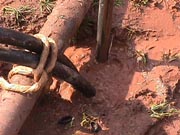
- 10 feet of a water line
- 50 feet of a water well, septic system, drainage zone of a building downspout, or below the collection basin of de-icing salts or barnyard runoff
- One-half the branch extremities of a tree or shrub.
Both manufacturers of DX systems - ECR Technologies Inc. and American Geothermal DX - recommend that soils be checked for high concentrations of acids, chlorides, hydrogen sulfide, sulfates or ammonia; they're to be avoided because of the potential for copper corrosion. ECR offers a cathodic protection system that emits a small, self-adjusting electric current that prohibits corrosion. To determine whether or not this is an issue, soil samples can be taken at a depth of 3 feet where the manifold pit would be placed.
An ECR manual states that soil samples are to be taken with a coring tube; they specifically recommend the LaMotte Model 1016. (Go to www.lamotte.com and type “1016” into its embedded search engine.) Soil samples then are tested for pH with a reliable pH-testing device. The one recommended by ECR is the LaMotte Model 1741.
Locations with a pH higher than 11 or lower than 6, or coastal areas with brackish water marshes, saltwater intrusion or acidic peat bogs are to be avoided unless cathodic protection is provided with an impressed electrical current. ECR's installation manual shows the general layout of the CPS system. Essentially, the anode location should be 50 feet from the nearest earth loop refrigerant line for pit or trench loop configurations. And, there must be no underground metallic lines between the anode and the earth loop system.
Once the earth loop (or geo field) is in, installation of a ground source heat pump is very similar to an air source installation. Geothermal condensing units (the enclosure with the compressor) don't require air circulation, as do typical air source systems, so they may be installed in a basement or utility room. System ducting and the setting of equipment are comparable.
There's one thing that direct-exchange geothermal drilling contractors fully agree on, and that's the need for training. Not only do they readily agree on the need for training before entering the field, they all place it as the first priority. “The training we got at both TEI Rock Drills and ECR made it possible for us to get into the business successfully, and thrive,” explains one driller. “Without it, all bets are off.”
Adds another: “We eagerly encourage drillers to consider the direct-exchange drilling. But, without the training, it would be futile. The training saved us so much time, prepared us for the work, made it possible for us to be profitable, and gave us the time to enjoy life, too. It's a move we'll never regret.”
ND
John Vastyan is a Manhein, Pa.-based journalist and communications professional whose work focuses on the geothermal, plumbing and mechanical and radiant heat industries. He can be reached at 717-664-0535, or by email: cground@ptd.net.

Sidebar: After the Drilling, Grouting Takes Center Stage
by David Harris
Installation of an earth loop system normally requires the need for drilling permits from the local oversight agency.
The permitting fees and grout seal depth requirements for the boreholes often vary, depending on the stated expectations of the city or county agency. Borehole grouting often is observed and documented by local oversight inspectors for approval and acceptance.
After the boreholes are drilled and the copper loops installed, the boreholes are sealed by pressure grouting with an approved grout slurry mix.
A 1-inch tremie pipe is installed into the borehole to within 3 feet to 5 feet of the bottom.
A grout mixture consisting of Type 2 cement, #30 fine silica sand, sodium bentonite, Superplastisizer and water is mixed using a chem-grout piston pressure pump or something similar. As the mix is pumped into the borehole, the tremie pipe gradually is removed.
If the boreholes are stable and can remain open, several can be grouted at one time. If they're unstable or caving conditions occur, each borehole must be grouted individually. The mix must have the proper amount of water to pump smoothly without clogging hoses and related piping. One of the things we always look for is an adequate supply of water at the jobsite. We need it not only for the grouting, but for cleanup of equipment without delays, too.
David Harris is the owner of Consolidated Testing Laboratories Inc., Porterville, Calif.
Report Abusive Comment